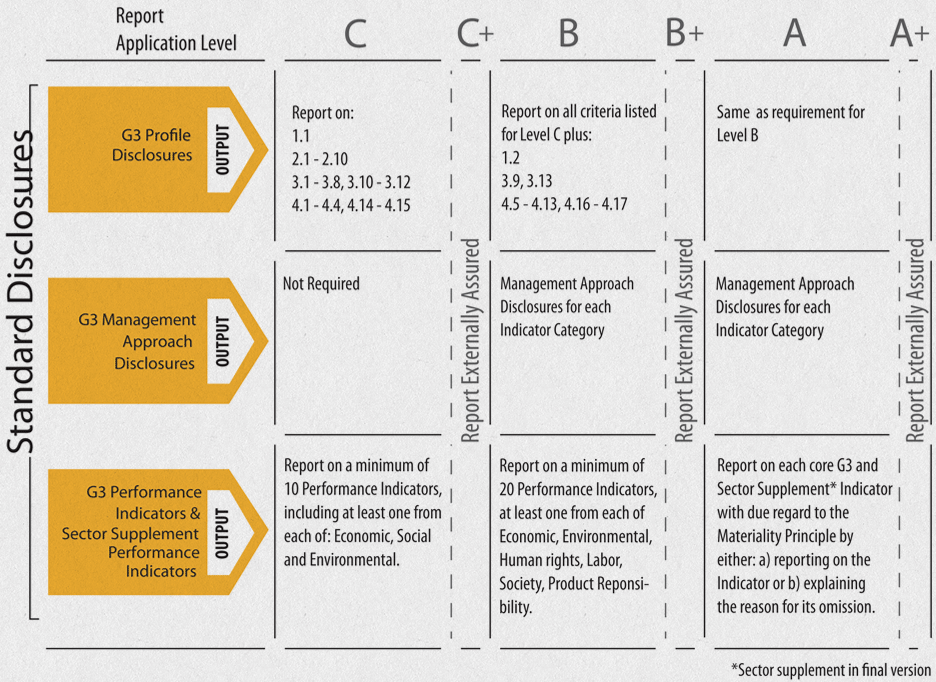Our GRI Application Level
Brady Corporation seeks to follow best practice in sustainability reporting. This report follows the Global Reporting Initiative's (GRI) G3.1 Sustainability Reporting Guidelines, at a self-declared application level of "C". Both the required Profile Disclosure elements, and the performance indicators reported on, are listed in our GRI Index Table, including links to the sections of the report where you can find more information.

| Element |
Description |
Location |
| 1. Strategy and Analysis |
| 1.1 |
Statement from the most senior decision-maker of the organization (e.g., CEO, chair or equivalent senior position) about the relevance of sustainability to the organization and its
strategy. |
 |
| 2. Organizational Profile |
| 2.1 |
Name of the organization. |
 |
| 2.2 |
Primary brands, products and/or services. |
 
|
| 2.3 |
Operational structure of the organization, including main divisions, operating companies, subsidiaries and joint ventures. |
| 2.4 |
Location of organization's headquarters. |
| 2.5 |
Number of countries where the organization operates, and names of countries either with major operations or that are specifically relevant to the sustainability issues covered in the
report. |
| 2.6 |
Nature of ownership and legal form. |
| 2.7 |
Markets served (including geographic breakdown, sectors served and types of customers/ beneficiaries). |
| 2.8 |
Scale of the reporting organization, including: number of employees; net sales (for private sector organizations) or net revenues (for public sector organizations); total capitalization broken down in terms of debt and equity (for private sector organizations); and quantity of products or services provided. |
| 2.9 |
Significant changes during the reporting period regarding size, structure, or ownership including: the location of, or changes in operations, including facility openings, closings, and expansions; and changes in the share capital structure and other capital formation, maintenance and alteration operations (for private sector organizations). |
 |
| 2.10 |
Awards received in the reporting period. |
 |
| 3. Report Parameters |
| REPORT PROFILE |
| 3.1 |
Reporting period (e.g., fiscal/calendar year) for information provided. |
 |
| 3.2 |
Date of most recent previous report (if any). |
 |
| 3.3 |
Reporting cycle (annual, biennial, etc.). |
 |
| 3.4 |
Contact point for questions regarding the report or its contents. |
| REPORT SCOPE AND BOUNDARY |
| 3.5 |
Process for defining report content, including: determining materiality; prioritizing topics within the report; and identifying stakeholders the organization expects to use the report. |
 |
| 3.6 |
Boundary of the report (e.g., countries, divisions, subsidiaries, leased facilities, joint ventures, suppliers). |
| 3.7 |
State any specific limitations on the scope or boundary of the report. |
| 3.8 |
Basis for reporting on joint ventures, subsidiaries, leased facilities, outsourced operations
and other entities that can significantly affect comparability from period to period and/or
between organizations. |
 |
| 3.9 |
Explanation of the effect of any re-statements of information provided in earlier reports and the reasons for such re-statement (e.g., mergers/acquisitions, change of the base years/periods, nature of business, measurement methods). |
 |
| 3.10 |
Significant changes from previous reporting periods in the scope, boundary or measurement methods applied in the report. |
| GRI CONTENT INDEX |
| 3.11 |
Table identifying the location of the Standard Disclosures in the report. |
 |
| 4. Governance, Commitments, and Engagement |
| ASSURANCE |
| 4.1 |
Governance structure of the organization, including committees under the highest governance body responsible for specific tasks, such as setting strategy or organizational oversight. |
 |
| 4.2 |
Indicate whether the Chair of the highest governance body is also an executive officer (and,
if so, their function within the organization's management and the reasons for this arrangement). |
| 4.3 |
For organizations that have a unitary board structure, state the number of members of the highest governance body that are independent and/or non-executive members. |
 |
| 4.4 |
Mechanisms for shareholders and employees to provide recommendations or direction to the highest governance body. |
  |
| STAKEHOLDER ENGAGEMENT |
| 4.14 |
List of stakeholder groups engaged by the organization. Examples of stakeholder groups are:
communities; civil society; customers; shareholders and providers of capital; suppliers; and
employees, other workers and their trade unions. |
 |
| 4.15 |
Basis for identification and selection of stakeholders with whom to engage. |
| 4.16 |
Approaches to stakeholder engagement, including frequency of engagement by type and by stakeholder group. |
| 5. Management Approach and Performance Indicators |
| ECONOMIC |
| Economic Performance |
| EC1 |
Direct economic value generated and distributed, including revenues, operating costs, employee compensation, donations and other community investments, retained earnings and
payments to capital providers and governments. |
  |
| ENVIRONMENTAL |
| Energy |
| EN3 |
Direct energy consumption by primary energy source. |
 |
| Emissions, Effluents, and Waste |
| EN16 |
Total direct and indirect greenhouse gas emissions by weight. |
 |
| EN18 |
Initiatives to reduce greenhouse gas emissions and reductions achieved. |
| EN22 |
Total weight of waste by type and disposal method. |
 |
| Products and Services |
| EN26 |
Initiatives to mitigate environmental impacts of products and services, and extent of impact mitigation. |
 |
| SOCIAL: LABOR PRACTICES AND DECENT WORK |
| Employment |
| LA1 |
Total workforce by employment type, employment contract and region. |
 |
| LA2 |
Total number and rate of new employee hires and employee turnover by age group, gender, and region. |

(partially reported) |
| Occupational Health and Safety |
| LA7 |
Rates of injury, occupational diseases, lost days and absenteeism, and number of work-related fatalities by region. |

(partially reported)
|
| Training and Education |
| LA10 |
Average hours of training per year per employee by employee category.
|

(partially reported) |


